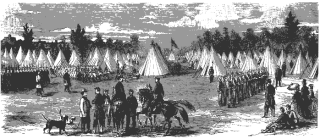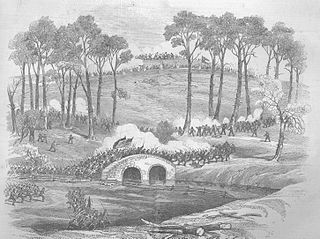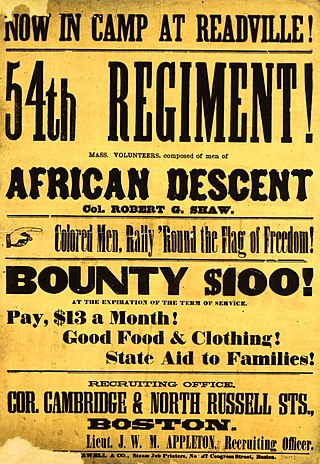Related Research Articles

Camp Curtin was a major Union Army training camp in Harrisburg, Pennsylvania, during the American Civil War. It was located north of Pennsylvania's state capitol building on 80 acres of what had previously been land used by the Dauphin County Agricultural Fairgrounds.

California's involvement in the American Civil War included sending gold east to support the war effort, recruiting volunteer combat units to replace regular U.S. Army units sent east, in the area west of the Rocky Mountains, maintaining and building numerous camps and fortifications, suppressing secessionist activity and securing the New Mexico Territory against the Confederacy. The State of California did not send its units east, but many citizens traveled east and joined the Union Army there, some of whom became famous.

The 7th Illinois Infantry Regiment was an infantry regiment that served in the Union Army during the American Civil War.

The 11th New York Infantry Regiment was an infantry regiment of the Union Army in the early years of the American Civil War. The regiment was organized in New York City in May 1861 as a Zouave regiment, known for its unusual dress and drill style, by Colonel Elmer E. Ellsworth, a personal friend of U.S. President Abraham Lincoln. Drawn from the ranks of the city's many volunteer fire companies, the unit was known alternately as the Ellsworth Zouaves, First Fire Zouaves, First Regiment New York Zouaves, and U.S. National Guards.

William Francis Bartlett was a general in the Union Army during the American Civil War and, later, an executive in the iron industry.

The 182nd Infantry Regiment is a regiment of the United States Army, forming part of the Massachusetts National Guard. It is among the oldest regiments in the U.S. Army, tracing its organizational roots back to 1636, and is one of several National Guard units with colonial roots and a campaign credit for the War of 1812.

The 51st Regiment Massachusetts Volunteer Infantry was a regiment of infantry that served in the Union Army during the American Civil War. The regiment was assigned to Major General John G. Foster's Department of North Carolina, later designated as the XVIII Corps. While based in New Bern, North Carolina, the 51st Massachusetts took part in several expeditions involving numerous units from Foster's command and were engaged in the Battle of Kinston, the Battle of White Hall and the Battle of Goldsboro Bridge, among other engagements.

The 21st Massachusetts Infantry Regiment was an infantry regiment in the Union Army during the American Civil War. It was organized in Worcester, Massachusetts and mustered into service on August 23, 1861.

The 181st Infantry Regiment shares the distinction of being the oldest combat regiment currently organized in the United States Army. It is one of several National Guard units with colonial roots and campaign credit for the War of 1812. The regiment traces its history to 13 December 1636, when it was one of four colonial regiments of foot of the British Crown in Massachusetts. It later served in the Continental Army during the American Revolution, with Union forces in the American Civil War, and as a federalized Massachusetts National Guard regiment with the U.S. Army during War with Spain, Mexican Border Campaign, World War I, and World War II. In 2006 Company A (Agawam) of the battalion deployed as a member of KFOR8 to Kosovo in support of Operation Joint Enterprise. Most recently the 1st Battalion, 181st Infantry has served in Iraq, in New Orleans following Hurricane Katrina, and in Afghanistan. The only active element of the regiment is the 1st Battalion, 181st Infantry Regiment, which returned from a year of service in Afghanistan in July 2011. The 1st Battalion was mobilized in March 2017 for one year of service with the Multinational Force & Observers in the Sinai Peninsula of Egypt. Currently, the 1st Battalion is a part of the 44th Infantry Brigade Combat Team, a major formation of the New Jersey National Guard. It was reflagged from the 50th Infantry Brigade Combat Team in 2017.

At the outbreak of the American Civil War Oregon also raised the 1st Oregon Cavalry that was activated in 1862 and served until June 1865. During the Civil War, emigrants to the newfound gold fields in Idaho and Oregon continued to clash with the Paiute, Shoshone and Bannock tribes of Oregon, Idaho and Nevada until relations degenerated into the bloody 1864 - 1868 Snake War. The 1st Oregon Volunteer Infantry Regiment was formed in 1864 and its last company was mustered out of service in July 1867. Both units were used to guard travel routes and Indian reservations, escort emigrant wagon trains, and protect settlers from Indian raiders. Several infantry detachments also accompanied survey parties and built roads in central and southern Oregon.
Camp Chase, also known as Camp Wilson, was a training camp for Massachusetts militia during the American Civil War located in Lowell, Massachusetts. Several thousand recruits were trained at Camp Chase before being sent south to the battle front.
Camp Edwin M. Stanton was an American Civil War training camp that existed from 1861-1862 in Lynnfield, Massachusetts. When the camp first opened in 1861 it was known as Camp Schouler, named for Massachusetts Adjutant General William Schouler. In some references it is mis-spelled as Camp Schuyler. After President Abraham Lincoln's call for 300,000 troops in July 1862, the camp was revived and renamed in honor of United States Secretary of War Edwin M. Stanton. It served as the training camp and rendezvous for recruits from eastern Massachusetts. The camp trained ten infantry regiments and four artillery batteries of the Massachusetts militia, including the 17th, 19th, 22nd, 23rd, 33rd, 35th, 38th, 39th, 40th, and 41st regiments of infantry and the 3rd, 5th, 9th, and 10th batteries of light artillery. Soldiers stationed at Camp Schouler/Stanton during training included Edward A. Wild, Henry Wilson, Nelson A. Miles, Edward Winslow Hinks, and Arthur F. Devereux. During World War I it was renamed Camp Houston and served as a Massachusetts National Guard mobilization camp in 1917. It was located on the Newburyport Turnpike near the Peabody, Massachusetts line. The camp was divided into streets, with tents and cook houses located on both sides of the Turnpike to Suntaug Lake.
Camp Andrew is a former American Civil War training camp that existed in 1861 in West Roxbury, Massachusetts. It was named for John A. Andrew, governor of Massachusetts at the time, and was used for the initial organization of the 2nd Massachusetts Infantry Regiment in May–July 1861. The site was on the former Brook Farm, a utopian community from 1841 through 1847. As a youth, Robert Gould Shaw was taken on visits to Brook Farm by his father. He is most famous as the commander of the 54th Massachusetts Infantry Regiment. In his early military career he trained at Camp Andrew as an officer of the 2nd Massachusetts.
Camp Cameron was an American Civil War training camp that existed in 1862 in North Cambridge, Massachusetts. It was used for the initial organization of elements of the 38th Massachusetts Infantry Regiment. It was probably named for Simon Cameron, Lincoln's first secretary of war. Other units that trained here included the 1st, 11th, 16th, 26th, and 28th regiments of Massachusetts infantry, and the 1st and 8th batteries of light artillery. It was located near Massachusetts Avenue, and was also known at one point as Camp Day after the family that owned the land. Cameron Avenue and Camp Street are named for the camp, and several nearby streets were named after battles.
Camp Ellsworth is a former American Civil War training camp that existed in 1862 in North Cambridge, Massachusetts. It was located near Fresh Pond, at the abandoned Reed and Bartlett Icehouse. It was first occupied by the 1st Regiment Massachusetts Volunteer Infantry on June 1, 1861.

Camp Meigs is a former American Civil War training camp that existed from 1862 to 1865 in Readville, Massachusetts. It was combined from the former Camp Brigham and Camp Massasoit and trained the 54th Regiment Massachusetts Volunteer Infantry, among others. The 54th regiment was one of the first official African-American units in the United States during the Civil War. The former camps were merged into Camp Meigs in August 1862.
Camp Prospect Hill was a former American Civil War training camp that existed in 1861 in Somerville, Massachusetts. It was located on Prospect Hill in the Union Square neighborhood of Somerville, on the site of an American Revolutionary War fort. Company E of the 39th Massachusetts Volunteer Infantry Regiment trained there.
Camp Framingham is a former Massachusetts National Guard camp that existed in 1873 to 1944 in Framingham, Massachusetts, also called Camp Dalton or Fort Dalton until 1898. The camp was used by all units of the Massachusetts Volunteer Militia as their summer training ground. The camp also contained a state arsenal where weapons and equipment was stored and issued to units. Fort Dalton was a training battery from 1883 to 1898, 138 feet (42 m) long with two 10 in (254 mm) Rodman guns and four siege mortars. Camp Framingham was used as a mobilization station during the Spanish–American War, in June 1916 during the Mexican border call-up and in the summer of 1917 during World War I. Other names for the camp in the Spanish–American War were Camp McGuinness and Camp Dewey. From May 1942 to December 1943, Headquarters, 181st Infantry Regiment was stationed with its companies serving on coast patrol duty for the Eastern Defense Command in New England. In 1948, Camp Framingham was transferred from the Military Division to the Massachusetts State Police. Today, the Massachusetts State Police and the Massachusetts Emergency Management Agency utilize portions of the former camp.

The 49th Regiment Massachusetts Volunteer Infantry was a regiment of infantry that served in the Union Army during the American Civil War. It was one of the 18 Massachusetts regiments formed in response to President Abraham Lincoln's August 1862 call for 300,000 men to serve for nine months. The regiment was recruited in Berkshire County and rendezvoused for mustering in at Camp Briggs in Pittsfield, Massachusetts. William F. Bartlett, a veteran of the 20th Massachusetts was voted colonel in command of the regiment. The 49th Massachusetts was assigned to the Department of the Gulf and saw heavy combat during the Siege of Port Hudson.

The 57th Regiment Massachusetts Volunteer Infantry was a regiment of infantry that served in the Union Army during the American Civil War. It was one of the four "Veteran Regiments" raised in Massachusetts during the winter of 1863–64. Recruits of these regiments were required to have served at least nine months in a prior unit. Colonel William F. Bartlett, at age 24 already a veteran of three regiments, organized the recruiting and formation of the 57th Massachusetts and served as its first commanding officer.
References
- ↑ "Western Massachusetts - Camp Lincoln". American Forts Network. Retrieved July 16, 2020.
- 1 2 Browne, Patrick. "Civil War Training Camps in Massachusetts, Part One". Historical Digression. Retrieved March 19, 2019.
- ↑ Roberts, Robert B. (1988). Encyclopedia of Historic Forts: The Military, Pioneer, and Trading Posts of the United States. New York: Macmillan. pp. 409–410. ISBN 0-02-926880-X.
